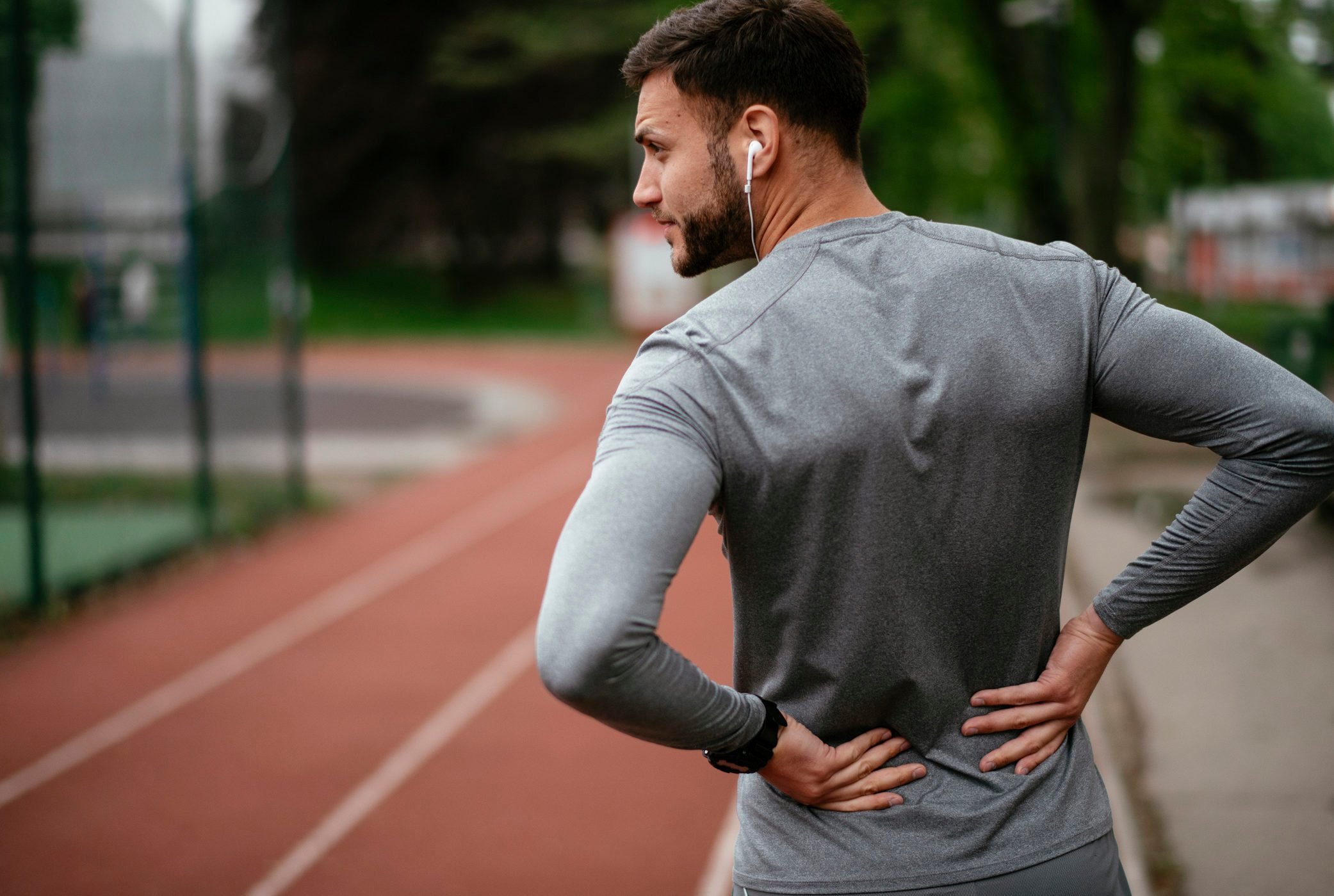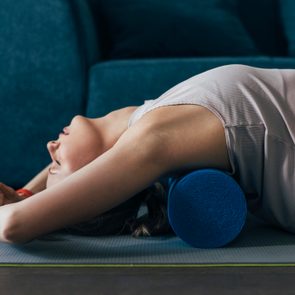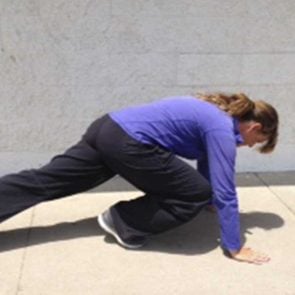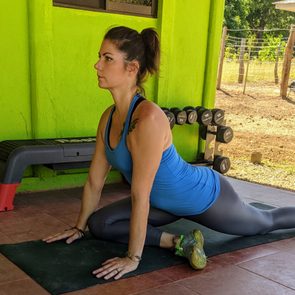Why You Can Get Lower Back Pain When Running
Updated: Mar. 11, 2022
Simple tweaks to how, where, and when you run can make a big difference in preventing and treating lower back pain when running.
Our editors and experts handpick every product we feature. We may earn a commission from your purchases.
Lower back pain when running
Running is great for your heart and your head, and you can do it nearly anywhere. But what if it causes or worsens your lower back pain?
Up to 80 percent of people will have a bout of back pain at some point in their lives, according to the U.S. National Library of Medicine, and runners seem to be at greater risk. “Running is a high-impact workout. It involves repetitive stress to the body for a long duration,” explains Gbolahan Okubadejo, MD, a New York City orthopedic surgeon. “Many runners experience back pain, especially in the lower back.”
The good news is that you don’t have to give up the activity you love if it bothers your back. There are simple ways to protect your back, including tweaking your stride, buying a new pair of kicks, and strengthening your core muscles.
Troubleshooting starts with identifying what is causing or worsening your low back pain.
All of that pounding the pavement may cause strains or sprains to the muscles in your back, damaged discs, nerve pain such as sciatica, or arthritis-related aching, says Jordan D. Metzl, MD, a sports medicine physician at the Hospital for Special Surgery in New York City and author of several books, including Dr. Jordan Metzl’s Running Strong: The Sports Doctor’s Complete Guide to Staying Healthy and Injury-Free for Life.
Here are some of the reasons you can get lower back pain when running.

Sprains and strains
Running may trigger sprains or strains in your back.
Causes
Much of this can be triggered by what’s known as ground reaction force (GRF). “Every time your feet hit the ground, the force travels up through your body to your spine. This is called the GRF,” Dr. Metzl says. When it’s too high and too strong, GRF can cause low back pain.
Your GRF is influenced by many factors, including how long your stride is and how strong your muscles and joints are, according to Dr. Metzl.
Symptoms
Low back pain and possibly spasms may occur if you strain or sprain your back while running.
Diagnosis and treatment
Stride length is the distance covered when you take two steps, one with each foot, Dr. Metzl explains. If your stride is too long, it can cause back pain, which is why shortening your stride can make a difference.
“Smaller strides will reposition your posture so that your foot strikes under your body, not in front, and this will better absorb the impact of that force,” Dr. Metzl says. He suggests seeking a gait evaluation from a physical therapist, biomechanical specialist, or kinesiologist.
(Here are 13 running terms every runner should know)
Strengthening your core can also stave off sprains and strains in your lower back. Your core muscles in your pelvis, lower back, hips, and abdomen all work together to support your spine and help better absorb that GRF, he says. This is why runners who have weaker core muscles may be more likely to develop back pain.
“Work with a physical therapist to design a core-strengthening regimen that works best for you,” Dr. Metzl suggests. (These are 19 of the all-time best core exercises that will get you in incredible shape.)
Arthritis
Osteoarthritis (OA), the wear-and-tear form of arthritis, can strike any joint in the body, including in your spine.
Causes
Runners may experience some back pain when cartilage in the joints breaks down and wears away, allowing the bones to rub together. It can occur from injury or overuse.
Symptoms
“This hurts like crazy,” Dr. Metzl says. You may feel pain or aching in your back while you are running or afterward. Sometimes the affected joint is swollen and inflamed as well.
Diagnosis and treatment
Your doctor will perform a physical exam and order imaging tests to see if the lower back pain you get from running is due to arthritis. Physical therapy, nonsteroidal anti-inflammatory drugs (NSAIDs) such as ibuprofen or naproxen, and sometimes injections of steroids may help relieve this pain and get you back out there, he says.
Slipped discs
Your lower back comprises five vertebrae (L1–L5), which are bones that support your upper body. Shock-absorbing discs are found between each one, and these discs can slip, tear, shift, or degenerate.
Causes
Running can cause the discs in your back to shift or degenerate. This may occur when your GRF is too strong, Dr. Metzl says.
Symptoms
When discs slip out of place, you can develop low back pain. Sometimes the disc will press on your sciatic nerve, causing nerve pain, numbness, weakness, or tingling that can radiate down your leg (known as sciatica), he says. (These are the signs of a slipped disc you could be ignoring.)
Disc problems are common and don’t always cause symptoms.
Diagnosis and treatment
Your doctor will examine you, ask detailed questions about your pain and when it first started, and order imaging tests. (This can lead to unnecessary surgery if a scan reveals a disc issue that doesn’t turn out to be the real cause of your pain.)
Treatment for disc issues usually involves pain medications and/or physical therapy. Sometimes steroid injections or surgery may be warranted, Dr. Metzl says.
Sacroiliac joint pain
Your sacroiliac joint connects your pelvis to your lower spine and works to absorb shocks between your upper body, pelvis, and legs.
Causes
Prolonged strenuous exercise such as running may cause sacroiliac joint pain, according to the American Academy of Physical Medicine and Rehabilitation.
Symptoms
Pain around the sacroiliac joint is the main symptom, and it may occur in your hip, back, and groin area, says Nikhil Jain, MD, a fellow in the Department of Neurosurgery at the University of Louisville School of Medicine.
Diagnosis and treatment
Your doctor can diagnose sacroiliac joint pain with a physical exam and possibly imaging tests. Treatment may involve stretching exercises, plus NSAIDs to relieve pain. Sometimes steroid injections help cool inflammation. Working with a physical therapist can help you learn the proper stretching and strengthening moves.
Lifestyle interventions
The actions you take before and after a run go a long way toward minimizing lower back pain.
“Studies suggest that stretching is beneficial to runners,” Dr. Okubadejo says, noting that stretches help target key muscles to keep the back stable and strong. “It’s important to go through a series of stretches prior to running. The body is a kinetic chain, and it works as a whole.”
For example, a tight heel cord (Achilles tendon) or calf can alter the length of your stride, which can affect the back, hips, and other joints, Dr. Okubadejo says. (Looking for an easy stretching routine? Try this.)
Dr. Metzl is a big fan of foam rolling to loosen up tight back muscles and stave off sprains and strains. Yoga and Pilates can also keep you limber, he adds. (Try these yoga poses for back pain relief.)
“Heat can loosen up your muscles, and ice after [a run] can help cool inflammation,” says Dr. Metzl.
Choose the right shoes
Choosing the right running shoe can also make a difference. There is no (literal or figurative) one-size-fits-all running shoe. “Variables need to be taken into account such as your weight, the shape of your feet, your biomechanics, and the kind of surface you are running on,” says Dr. Okubadejo.
Shoe choice matters if you are going for speed versus distance. “Lighter shoes typically have less cushioning, which makes them lighter and can enable you to move faster,” he says. “But if you are going for a distance, more cushioning is better.”
Know where and when to run
One of the best things about running is that you can do it anywhere: the beach, street, track, treadmill—you name it. But not all surfaces are equally kind to the back and body, says Dr. Okubadejo.
The safest choice is the treadmill, where conditions are the most controlled, he says. Other than a treadmill, a track is likely your safest bet, especially if you’re just recovering from a running injury. “This offers a level surface as well as good shock absorption,” says Dr. Okubadejo. Many high schools have tracks that are open for runners on weekends.
Each outdoor surface has its own set of pros and cons. “Running on a beach builds leg strength. However, the soft sand means a higher risk of Achilles tendon injury,” says Dr. Okubadejo. “Firmer sand at the water’s edge puts uneven stress on the body.”
If you are running on asphalt, beware of potholes, uneven surfaces, and traffic. “This is tough surface that can be punishing to the back,” Dr. Okubadejo says. Even more punishing? Concrete. According to Dr. Okubadejo, it’s 10 times as hard as asphalt and can lead to injury.
Benefits of running for your back
Now for the upside: Running may be good for your back, according to Dr. Okubadejo.
Research suggests that runners have healthier discs than people who don’t exercise. In a study published in Scientific Reports, researchers found that runners’ discs were larger and contained more fluid—signs of healthier discs—than the discs of the men and women who did not exercise.
Being overweight or obese ups the risk for back problems and other health issues, but running can help you maintain a normal weight, which keeps extra pressure off of your joints.
“For those who have back pain with a structurally normal spine and a weak core, running can help to strengthen the core, which in turn helps the back,” Dr. Okubadejo says.
The last word
Running can cause low back pain, but making changes to your stride or shoes and/or strengthening your core can help lower this risk. “You may have to modify how much you are running or the distance, but we want to keep people moving, and complete rest can result in a lot of atrophy,” Dr. Metzl says. Running can also stave off lower back pain by keeping your back healthy, your weight down, and your core muscles strong.























